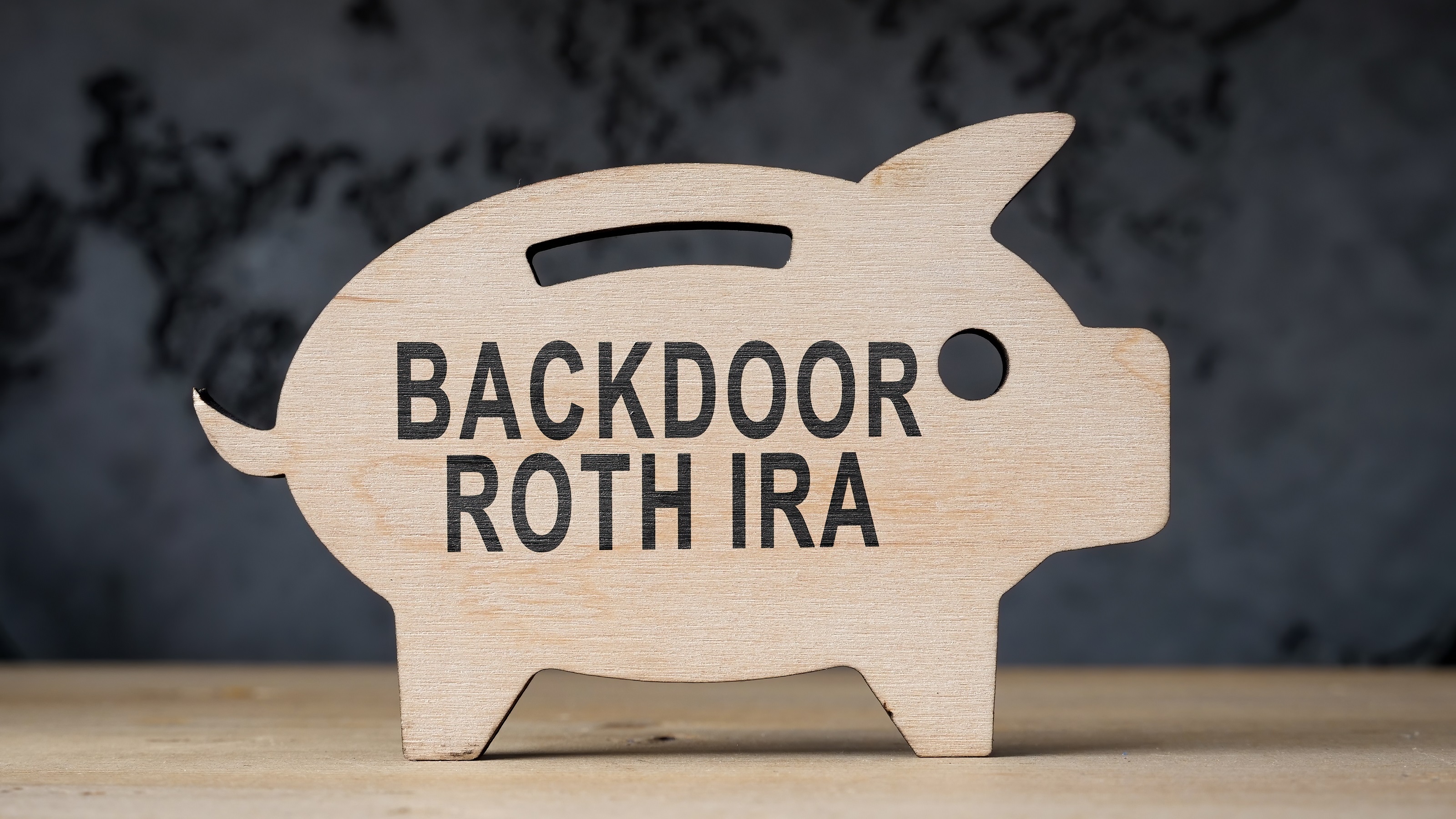Backdoor Roth IRAs: Good for Wealthy Retirees?
A backdoor Roth IRA is a loophole that enables wealthier individuals to earn tax-free income. But it's complicated.


The Roth IRA is that rare prize in the U.S. Tax code — a way to earn tax-free income.
Savers using Roth IRA accounts withdraw their investment gains completely tax-free in retirement. But because the government designed this generous tax break for the middle class, the Roth has strict income limits for who can use it.
In 2025, Roth IRA limits mean you cannot contribute directly to a Roth IRA if you're single and have a modified adjusted gross income of more than $165,000 or are married with a joint modified AGI over $246,000.

Sign up for Kiplinger’s Free E-Newsletters
Profit and prosper with the best of expert advice on investing, taxes, retirement, personal finance and more - straight to your e-mail.
Profit and prosper with the best of expert advice - straight to your e-mail.
Wealthier investors, however, can still access these accounts indirectly through a backdoor Roth IRA.
"This strategy gives a workaround for the Roth IRA income restrictions," says Rob Burnette, a financial adviser and tax preparer at Outlook Financial Center in Troy, Ohio.
Backdoor Roth IRA ins and outs
A backdoor Roth IRA is a two-step process. First, you open a traditional IRA using after-tax dollars instead of the pre-tax money you usually fund these accounts with.
Nondeductible contributions are not only simpler for the backdoor strategy but also circumvent the income limits for deductible traditional IRA contributions, which are even more restrictive than those for a Roth (if you have a retirement plan at work and either you or your employer contributed to it).
Second, you convert the traditional IRA to a Roth, but because none of the contributions were deductible, no income tax is owed on the conversion. You report to the IRS that your contributions were nondeductible using Tax Form 8606 when you file your return.
There are no income limits for setting up nondeductible IRAs or making a Roth conversion, so the backdoor strategy is available to everyone.
Contributions through the back door have the same annual maximums in 2025 as other IRAs: $7,000 for people younger than 50 and $8,000 for those 50 or older, provided they have at least that amount in earned income.
Beware of the Pro-Rata rule
A backdoor Roth IRA conversion can be made every year, but if you've contributed pre-tax money to a traditional IRA in the past, a tax law called the pro-rata rule complicates things.
Under the pro-rata rule for Roth conversions, the IRS looks at the proportion of pre-tax versus after-tax dollars in your traditional IRA. This is the percentage that will be taxable when you make a backdoor Roth conversion.
For example, let's say you have $95,000 of pre-tax funds in a traditional IRA and you contribute another $5,000 of nondeductible money. You might think that you could just convert the $5,000 of nondeductible money and avoid owing any additional taxes.
Instead, thanks to the pro-rata rule, the IRS considers 95% of each dollar you convert as taxable ($95,000/$100,000).
Only $250 of your $5,000 conversion in this instance is tax-free while the rest is taxed as income. Your taxable income for the year would also increase by the amount of the taxable conversion.
An effective strategy for some
For this reason, the backdoor Roth IRA strategy is most tax-effective for those who haven't already funded a traditional IRA with pre-tax dollars. The IRS looks at all your IRAs in aggregate.
If you have an existing traditional IRA with Schwab, you can't dodge the taxes by opening a new IRA with Vanguard.
Pfau warns that if you have your money in an old workplace plan, like a 401(k), "people can really mess themselves up by making a large 401(k) rollover into a traditional IRA." Because of the pro-rata rule, moving over a large pre-tax retirement balance will hamper your ability to make tax-free transfers in the future for a backdoor Roth IRA.
If you plan on using this strategy, leave the funds in your old workplace retirement plan, or if you're still working, transfer the balance to a new employer's retirement plan.
You could also ask your employer if you can transfer your pre-tax dollars in a traditional IRA to your workplace plan to get around the pro-rata rule.
Because of the rule, keep your nondeductible funds in cash in the traditional IRA and don't invest until after you've made the conversion.
Otherwise, you'll owe income tax on the investment gains from the nondeductible funds when you convert to the Roth.
That's why Pfau recommends making your backdoor Roth conversion all at once, putting the entire amount in your account in January and making the conversion right away.
Withdrawals and taxes
Other tax rules to watch out for involve withdrawals. When you fund a Roth IRA with direct contributions, you must wait at least five years and until age 59-½ to take out your investment gains tax-free. Your contributions can be withdrawn tax-free anytime.
With a Roth conversion, you must hold the account for at least five years or until age 59-½, whichever comes first, to avoid a 10% early withdrawal penalty that is applied to every dollar you convert, both contributions and gains. You also must wait five years for tax-free withdrawals of your gains, regardless of your age.
This tax rule gets complicated when you make multiple backdoor conversions. "Every conversion has its own five-year clock," says Samuel Eberts, a financial adviser and registered financial consultant with Dugan Brown in Columbus, Ohio.
He recommends working with a tax professional to track your conversions and investment gains so you can figure out when and how much you can take out tax and penalty-free.
Despite those complications, Eberts believes it's worth having at least some retirement savings in a tax-free account for greater tax flexibility in retirement.
Unlike traditional IRAs, Roth accounts don't require minimum withdrawals at age 73. You can hold onto those retirement savings for the future or leave them as an inheritance.
Meanwhile, if you need the money in retirement, the withdrawals won't add to your taxable income, which can affect government benefits.
"Distributions from a Roth IRA don't count toward whether you owe taxes on your Social Security or [pay] extra for your Medicare premiums," says Pfau.
Backdoor Roth IRA disadvantages
A backdoor Roth IRA enables you to earn tax-free income, but like any savings or investment vehicle, it is not without downsides. The downsides include:
Potential taxes. With many conversions, you're on the hook for taxes on the amount converted from a traditional IRA to a Roth IRA.
Higher tax bracket. The conversion could push you into a higher tax bracket, which means more income taxes.
The five year rule. Even if you are over the age of 59-1/2, you have to wait five years after the conversion to access the funds tax free. If you run afoul of this rule you could face a 10% penalty.
A Washington curve ball
If you think the backdoor Roth IRA strategy sounds suspiciously like a giant tax loophole, some in Congress might agree with you.
Reports of billionaires funding Roths through the back door have put this strategy on Congress's radar, with some Democratic lawmakers looking to restrict the practice or even abolish it altogether.
While the IRS backed restrictions to this tax loophole, it stopped short of siding with blocking it, says Wade Pfau, a professor of retirement income at The American College of Financial Services. It's not clear what the Trump Administration will do with the backdoor Roth IRA.
Some detractors of backdoor Roth IRAs held out hope that the U.S. Supreme Court would outlaw the tax, but the court kicked the issue back to Congress in June 2024.
The backdoor Roth IRA strategy looks safe for now. What happens next is anyone's guess.
"Trying to predict what Congress is going to do is like playing with the old magic eight ball," says Burnette. Nevertheless, he warns that when Congress decides to act, it can do so quickly.
Pfau believes that if Congress does abolish the backdoor Roth IRA, the law is unlikely to be retroactive and wouldn't cancel out transactions that already happened.
The possibility of such a grandfather clause could be an incentive to pursue a backdoor Roth sooner rather than later.
"As long as any future law is not retroactive, you'll be better off doing it now while you still can," says Pfau.
Related Content
- Estate Planning for Millionaires
- Should You Use a Roth or Traditional IRA?
- Qualify for Roth IRA Contributions by Lowering Your Income
- Seven Reasons to Avoid a Self-Directed IRA
Get Kiplinger Today newsletter — free
Profit and prosper with the best of Kiplinger's advice on investing, taxes, retirement, personal finance and much more. Delivered daily. Enter your email in the box and click Sign Me Up.

David is a financial freelance writer based out of Delaware. He specializes in making investing, insurance and retirement planning understandable. He has been published in Kiplinger, Forbes and U.S. News, and also writes for clients like American Express, LendingTree and Prudential. He is currently Treasurer for the Financial Writers Society.
Before becoming a writer, David was an insurance salesman and registered representative for New York Life. During that time, he passed both the Series 6 and CFP exams. David graduated from McGill University with degrees in Economics and Finance where he was also captain of the varsity tennis team.
- Donna FuscaldoRetirement Writer, Kiplinger.com
- Erin BendigPersonal Finance Writer
-
 Lowe's Stores Closing All Locations for 24 Hours: When and Why
Lowe's Stores Closing All Locations for 24 Hours: When and WhyLowe's will close all of its retail locations and contact center for one day in April.
By Sean Jackson Published
-
 Are You Ready to Pay More Taxes to Save Social Security?
Are You Ready to Pay More Taxes to Save Social Security?Social Security Across party lines, many believe saving Social Security trumps other financial considerations.
By Kelley R. Taylor Published
-
 Little-Known Ways to Guard Your Retirement Income
Little-Known Ways to Guard Your Retirement IncomeIs your retirement income safe if stocks continue to plummet? Most retirees don't know these reliable options to limit their market exposure.
By Jacob Cornell Published
-
 Three Warning Signs Your Investments Are (Needlessly) Too Risky
Three Warning Signs Your Investments Are (Needlessly) Too RiskyAll investments come with risk, but the secret is to take only enough risk to get you to your specific savings goals — and no more than that.
By Eric Roberge, Certified Financial Planner (CFP) and Investment Adviser Published
-
 Reduce Your Retirement Tax Risk With the Three-Bucket Strategy
Reduce Your Retirement Tax Risk With the Three-Bucket StrategySplitting retirement funds into three buckets with distinct tax treatments can help you avoid a nasty tax bill down the line. Here's how the strategy works.
By Bryan S. Slovon, Investment Adviser Published
-
 Retire in Mexico: Get a Lower Cost of Living Near the US
Retire in Mexico: Get a Lower Cost of Living Near the USMany older Americans retire in Mexico because of its laid-back lifestyle, beaches, and vibrant culture. Here’s the scoop on living in Mexico full-time.
By Brian O'Connell Published
-
 Financial Fact vs Fiction: This Roth Conversion Myth Could Cost You
Financial Fact vs Fiction: This Roth Conversion Myth Could Cost YouWhile some 'golden rules' stay in style forever, the financial landscape is constantly evolving. Here are five common myths to revisit (with more on the way).
By Scott McClatchey, CFP® Published
-
 Give Now or Leave an Inheritance? How to Balance the Options
Give Now or Leave an Inheritance? How to Balance the OptionsYou've saved enough money for retirement. But can you afford to give some to family or good causes — and when is best? These are the key points to consider.
By Deana Healy, CFP® Published
-
 How to Age-Proof Your Retirement Plan
How to Age-Proof Your Retirement PlanLongevity risk is a big threat to your retirement, but there are several strategies to protect yourself from running out of money, no matter how long you live.
By Nico Pesci Published
-
 Retirement Planning for Couples With a Generation Gap
Retirement Planning for Couples With a Generation GapDo you and your partner have different retirement timelines and attitudes to saving? It is possible to make plans together. This is how one couple did it.
By Phil Wright, Certified Fund Specialist Published